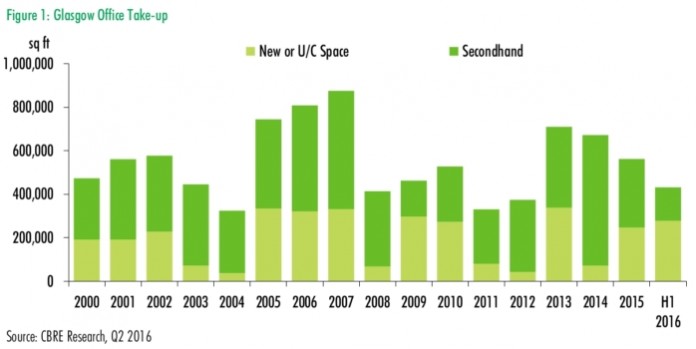Leading property consultant CBRE’s H1 2016 Office Market View research report has shown the central belt, in particular Glasgow, experienced high volumes of occupier demand in the first half of 2016. The Aberdeen market continues to be affected by last year’s drop in energy prices however activity in the city is stirring again with a couple of new speculative city centre developments.
GLASGOW
The Glasgow office market has had an exceptional start to 2016 with a total of 431,982 sq ft of take-up during the first six months of the year. This is the third highest total for the first half on record, bettered only by 2006 and 1994. It represents a 75% increase on the same period of 2015 and 87% up on the five year average.
A 155,000 sq ft pre-let to Morgan Stanley at Bothwell Exchange has primarily led to this strong level of take-up. Glasgow has also seen numerous other large deals this year including ACCA taking 55,744 sq ft at 110 Queen Street and AXA Insurance’s acquisition of 49,424 sq ft at Cuprum. While these inflated statistics are in part due to the Morgan Stanley pre-let at Bothwell Exchange, even if this transaction is removed from the Glasgow figures the H1 2016 take-up is still 13% up on H1 2015 and 20% up on the five year average.
The amount of available space in Glasgow at the end of quarter 2 2016 was 1.5m sq ft across the city centre. Supply levels are now the lowest they have been since Q4 2007, completely reversing the period of high supply that immediately followed the global financial crisis. Grade A floor space in particular is rapidly depleting with just 201,716 sq ft available. Whilst the city benefits from a number of development sites with existing planning consent there are no new site starts at present.
Audrey Dobson, senior director in CBRE’s National Office Agency team in Glasgow, commented: “The Glasgow office market has experienced unprecedented take-up levels during H1 2016, not seen since before the global recession. Supply of accommodation is now severely restricted as Glasgow is unique in the regional markets as it does not have any speculative developments in the pipeline as yet. This may lead to occupiers committing to pre-lets to satisfy their requirements.”
In Glasgow prime rents currently stand at £29.50 per sq ft; it is expected that rents will remain stable for the best quality product for the remainder of this year.
Audrey Dobson continued: “We are expecting a quieter second half of the year so far. Lease requirements at the start of the summer break are down, but this is largely a feature of where Glasgow currently sits within its occupational cycle. Most of the city’s major occupiers have already committed to moves in the past twelve to eighteen months. Glasgow also was able to deliver new speculative space early on in the cycle, allowing those occupiers to commit at an earlier stage. Going forward, we do therefore expect constrained supply levels to have an impact on take-up, particularly of Grade A space.”
The investment market for office space in Glasgow changed dramatically at the end of the second quarter. Prior to the EU Referendum, demand levels had dipped slightly with a thinner market than had been the case in recent years. Nevertheless there have been new entrants into Glasgow, particularly overseas buyers seeking good value stock in the £5-£20m price bracket. As such overall investment volumes have been lower this year, totalling just over £94m during the first half. The highest value deal saw TH Real Estate acquire 2 West Regent Street for £31.5m.
EDINBURGH
For the third year in succession, the occupier market in Edinburgh has seen a strong level of take-up with 451,390 sq ft acquired during the first six months of 2016. A number of large deals of over 25,000 sq ft have taken place across the city and involving a range of occupiers. At South Gyle Business Park, Napier University acquired over 100,000 sq ft in quarter 1, whilst in the city centre, the remaining space at Quartermile 4 was let to Cirrus Logic at the very start of the year.
Looking ahead, some of the occupiers with major requirements in the office sector, who began searching before the EU Referendum, continue to look for space in the city and could provide a robust base to take-up in the second half. They include EY (30,000 sq ft), State Street Bank (60,000 sq ft) and Aberdeen Asset Management (60,000 sq ft).
As noted in previous reports, the creative industries in Edinburgh continues to form a significant share of overall take-up, accounting for 22% of take-up so far this year. This relatively new sector for the city is followed by the more traditional professional services sector, with 21% take-up.
Total office availability at the end of 2015 was 1.48m sq ft, a small increase of 2% since the end of 2015. Despite this supply remains at 54% of its peak in 2009, currently at its lowest level for over a decade. However there are now two buildings currently under construction: Quartermile 3 (74,000 sq ft) and 2 Semple Street (37,500 sq ft). Further development sites are almost ready to proceed including Capital Square in the Exchange District. Given current requirements, further pre-letting in the city cannot be ruled out. This is likely to extend to the prime developments not yet on-site but with certainty around deliverability.
Prime rents in Edinburgh increased to £31.00 per sq ft and have remained at that level during the first half of 2016. Whilst supply and demand dynamics would suggest further growth is possible, a pause in the short term is expected as the market considers the implication of the Brexit vote. However, any impact is likely to be related to adjustments in lease incentives, rather than headline rents.
Stewart Taylor, senior director in CBRE’s National Office Agency team in Edinburgh, said: “How the Scottish occupational markets will be affected by the double hit of Brexit and the inevitable possible follow-on of Indyref 2 is uncertain at the moment. In the short term, speculative funding will almost certainly become harder to get making it even more difficult to move schemes over the starting line to meet the shortage of Grade A stock.”
The first half of 2016 saw strong office investment activity, despite weaker investment activity in the run up to the EU referendum. A total of £265 million transacted across six deals, albeit this was skewed by two large transactions: DEKA acquired Atria Edinburgh for £105.25m and TRIUVA acquired Quartermile 4 from M&G for £68.5m.
The market is now adapting to the new Brexit reality. Investor sentiment has clearly weakened amid the increased uncertainty. However, with interest rates remaining low, and potentially falling further, and the overriding strength of the city’s occupier market, current yields look sustainable for the foreseeable future and will be particularly attractive for overseas buyers following the falls in the value of Sterling.
ABERDEEN
Office space take-up in Aberdeen in the first half of 2016 was subdued at 88,570 sq ft, despite a rise in the Brent Crude oil price from a low of circa $20 per barrel in January to around $50 per barrel in June. This is still low compared to a recent period of sustained high oil prices and the knock on effect continues to be an effort from energy companies to reduce costs and headcount.
The main drivers in the market have been a mix of professional companies and government bodies with AB1 securing both the Department of Energy and Climate Change and the Crown Office and The Capitol’s top floor letting to PWC completing. Aberdeen Journals has also announced it has agreed terms for 19,000 sq ft for the top floor of 1MSq at Marischal Square – the first office occupier announced for the speculative development which completes in July 2017.
Derren McRae, managing director of CBRE in Aberdeen, said: “There has been steady recovery in oil price from the start of the year, however the current pricing remains at a level where it is necessary for energy sector companies to continue to implement cost cutting measures and reduce head count.
“The office market has certainly shifted in the favour of the tenant, however it is particularly encouraging to see activity in the new speculative city centre developments with PWC committing to The Capitol and Aberdeen Journals announcing its intention to relocate operations to Marischal Square.”
Availability at the end of H1 2016 increased to 2.25m sq ft, 78% of which is second-hand Grade B stock, and there is approximately 500,000 sq ft of newly completed or under construction space available on the market. No further speculative office development will take place in the city until there is a positive upturn in the energy sector.
Prime rents in the city have remained at £32.00 per sq ft and it is anticipated headline rents will remain at this level. However, it is expected that rents will fall in peripheral locations, with incentive levels likely to increase across all office space as a consequence of current office dynamics.
Activity in the Aberdeen investment market slowed significantly in the first half of the year. As well as the impact of lower oil prices, the market also faces challenges of weaker demand following the EU Referendum as well as concerns amongst some investors of the prospect of a second referendum on Scotland’s independence.
Despite the clear headwinds, CBRE believes Aberdeen to be one of the only regional cities that can offer long term income deals with guaranteed uplifts throughout the term of discounted pricing in comparison to the rest of the country.

















